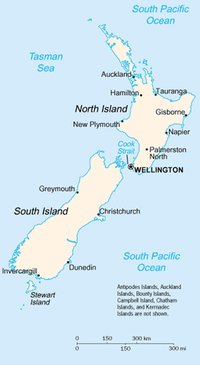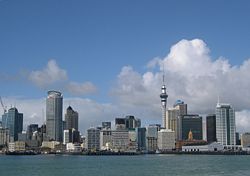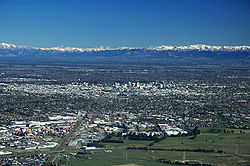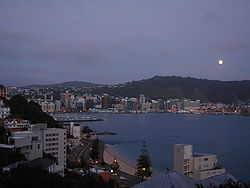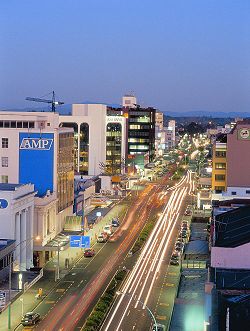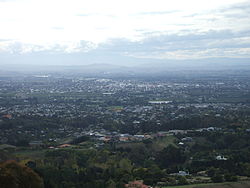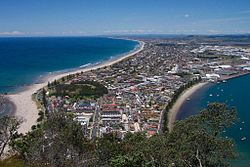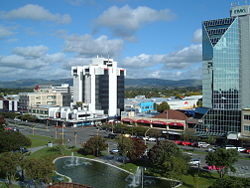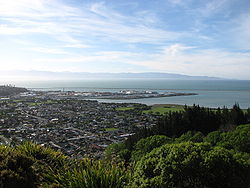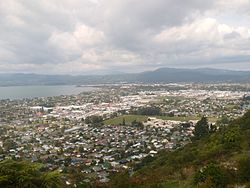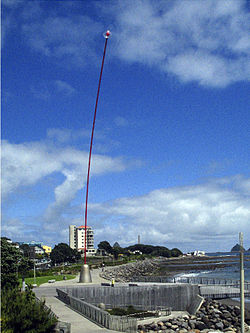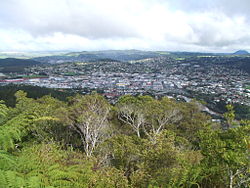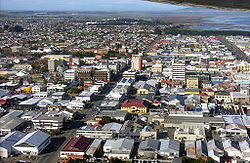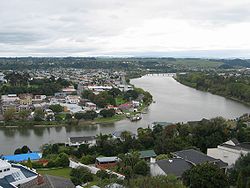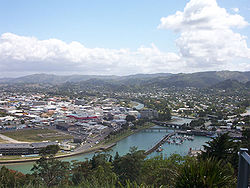- List of cities in New Zealand
-
After the local government reforms of 1989, the term "city" began to take on two meanings in New Zealand. Before 1989, a borough council with more than 20,000 people could be proclaimed a city. The boundaries of councils tended to follow the edge of the built-up area, so little distinction was made between the urban area and the local government area.
In 1989, the structure of the local governments in New Zealand was significantly reorganized. The new district councils and city councils were nearly always much larger geographically, and they covered both urban land and the surrounding rural land. Many locations that once had had a "city council" are now being governed by a "district council".
The word "city" began to be used in a less formal sense to describe the urban areas of New Zealand independent of local body boundaries. This informal usage is jealously guarded. The district government of the town of Gisborne, for example, adamantly described itself as the first "city" in the world to see the new millennium. However, Gisborne is governed by a "district council", but its status as a city is not generally disputed in New Zealand.[citation needed]
Contents
Urban areas by population
The populations given in the table below are provisional New Zealand resident populations, June 2010 estimates,[1] and they refer to the entire urban area, unless otherwise stated.
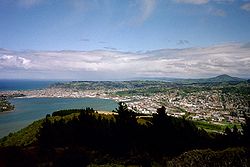 Panorama of Dunedin
Panorama of Dunedin Rotorua from Mt. Ngongotaha
Rotorua from Mt. Ngongotaha Whanganui from Durie Hill
Whanganui from Durie Hill
Rank (population) Urban area Population Area
(km²)[2]Population
Density
(people/km²)Notes 1 Auckland 1,354,900 1,086 1,247.6 2 Christchurch 390,300 608 641.9 3 Wellington 389,700 444 877.7 1. 4 Hamilton Urban Area 203,400 877 231.9 2. 5 Napier-Hastings Urban Area 124,400 375 331.7 3. 6 Tauranga 120,000 178 674.2 7 Dunedin 116,600 255 457.3 8 Palmerston North 81,600 178 458.4 9 Nelson 59,800 146 409.6 10 Rotorua 55,900 89 628.1 11 New Plymouth 52,200 112 466.1 12 Whangarei 51,900 133 390.2 13 Invercargill 48,700 123 395.9 14 Whanganui (Wanganui) 39,700 105 378.1 15 Gisborne 34,200 85 402.4 Notes:
- Kapiti Coast (40,000) is the only urban area not listed by the Statistics New Zealand organization. The Kapiti Coast District includes the townships of Paekakariki, Raumati, Paraparaumu; Paraparaumu Beach, and Waikanae; and the village of Pekapeka, and is not considered to be a city by Statistics New Zealand. The Kapiti Coast is considered by most Wellingtonians as being part of the Greater Wellington Area - though not by Statistics New Zealand. Hundreds of people here commute daily to Wellington for work, and the suburban commuter railroad network ends in the Kapiti District. If Kapiti were added to Wellington the total population of the Wellington Urban Area would be approximately 430,000.
- The population for the Hamilton urban zone is 171,600, the Cambridge urban zone is 16,400 and the Te Awamutu urban zone is 15,450.
- The population figures for the Hastings urban zone is 65,700, and for Napier 58,600.
- Blenheim (30,200) is sometimes referred to as a city, especially by locals, although its (former) borough council was never proclaimed a city.
- Timaru (27,600) once had a city council, but it is now administered as part of a district council. It is classified as a secondary urban area by Statistics New Zealand.
- Pukekohe, a settlement not far south of Auckland, has an estimated population of 25,600.
- Taupo in the central North Island and with an estimated population of 22,300 is rarely referred to as a city.
- Masterton, the main centre in the Wairarapa, is rarely referred to as a city. It has an estimated population of 20,100.
- Tokoroa in the South Waikato district was long expected to become a city when its population continued to grow past 18,000 during the 1980s. However, with the fallback in the forestry industry, Tokoroa's main industry, many jobs were lost and Tokoroa's population declined. It now has 13,400 residents.
- Levin, the main centre in the Horowhenua district, with an estimated population of nearly 20,000 is also not considered to be a city.
City councils
The populations given are the Statistics New Zealand estimated resident population (June 2010 estimate).[1]
City Council Population First Proclaimed Ranking (size) Auckland 1,462,000 1871 1 Hamilton 143,000 1936 4 Tauranga 114,300 1963 6 Napier 57,600 1950 9 Palmerston North 81,300 1930 8 Porirua 52,100 1965 11 Upper Hutt 41,100 1966 13 Lower Hutt 102,700 1941 7 Wellington 197,700 1870 3 Nelson 45,500 1874 12 Christchurch 376,700 1868 2 Dunedin 124,800 1865 5 Invercargill 52,400 1930 10 Many cities were reorganised into districts by the Local Government Commission in 1989 under the Local Government Act 1974, for example, Timaru. The most recently proclaimed city is Tauranga, which became a city, for the second time, from 1 March 2004. Another former city is Rotorua. Some present cities, such as Christchurch (1862 and 1868) and Invercargill (1930 and 1991), have been declared cities more than once.
Under Section 27 of the Local Government Act 2002, a district may become a city by either a reorganisation scheme with the Local Government Commission, or under Section 27(1) it may apply for a change in status under Schedule 3, Clause 7. The new city must have 'a population of not less than 50,000 persons', be 'predominantly urban' and 'a distinct entity and a major centre of activity within the region' (or regions) that it is encompassed by. Existing cities are grandfathered under Schedule 2, Part 2 of the Act. The only new city council so far under this section is the Tauranga City Council, from 1 March 2004.
Previously, under Section 37L of the Local Government Act 1974, new cities could only be formed from a reorganisation scheme. The same criteria were used. The last city to be constituted under this section was Invercargill, which was re-reorganised into a city in 1991.
In 1991 the Lower Hutt City Council became the Hutt City Council by a special Act of Parliament [1] that which did not change the name [2] of the city of Lower Hutt; the city's coat of arms still refers to the City of Lower Hutt.
Cities during provincialism, 1852 to 1876
During provincialism in New Zealand, from 1852 until abolition in 1876, there was no uniform system of local authorities in New Zealand. There is thus some argument over which of the following cities was the first.
- Nelson (1858, by Letters Patent)
- Christchurch (November 1862, revoked June 1868, both by provincial ordinance, and restored October 1868 by Act of Parliament)
- Otago (later Dunedin) (July 1865)
The Municipal Corporations Act 1876 included the first schedule of cities, with the dates they were constituted. Dunedin was the first city in New Zealand to be described in an Act of Parliament as 'City of...', something now automatic under the Local Government Act 2002.
- Dunedin (4 July 1865)
- Christchurch (28 May 1868)
- Wellington (16 September 1870)
- Auckland (24 April 1871)
- Nelson (30 March 1874)
Cities, 1877 to 1989
Up to October 1989, the Local Government Commission undertook reorganisations of local government. As a result, some cities were reorganised into other cities or changed to districts, and some of these areas are still considered cities by many New Zealanders. This is a list as at circa 1986.
- North Island
- Whangarei (1964)
- Auckland
- Auckland (1871)
- East Coast Bays
- Takapuna
- Birkenhead
- Waitemata (1974)
- Mt Albert
- Papatoetoe
- Manukau (1965)
- Papakura
- Tamaki
- Hamilton (1936)
- New Plymouth (1949)
- Tauranga (1963)
- Rotorua (1962, merged into Rotorua District, 1979)
- Gisborne (1955)
- Napier (1950)
- Hastings (1956)
- Wanganui (1924)
- Palmerston North (1930)
- Wellington
- Wellington (1870)
- Upper Hutt (1966)
- Lower Hutt (1941)
- Porirua (1965)
- South Island
- Nelson (1874)
- Christchurch (1868)
- Timaru (1948)
- Dunedin (1865)
- Invercargill (1930)
See also
- List of cities in Oceania
- City status in the United Kingdom
- List of towns in New Zealand
- List of main streets of New Zealand cities
- List of cities in the Cook Islands
- List of cities in Niue
- List of cities in Tokelau
- Ranked list of New Zealand main urban areas
- Territorial Authorities of New Zealand
Notes
- ^ a b "Subnational population estimates at 30 June 2010 (boundaries at 1 November 2010)". Statistics New Zealand. 26 October 2010. http://www.stats.govt.nz/~/media/Statistics/Methods%20and%20Services/Tables/Subnational%20population%20estimates/subpopest2001-10.ashx. Retrieved 7 March 2011.
- ^ "Freedom from Crowding: Living Density Table 1". Statistics New Zealand. http://www.stats.govt.nz/Publications/StandardOfLiving/housing-statistics/freedom-from-crowding.aspx. Retrieved 28 January 2010. (Areas are based on 2001 boundaries. Water bodies of areas greater than 15 hectares are excluded)
References
- Gordon McLauchlan (Editor), Illustrated Encyclopedia of New Zealand, The, Auckland: David Bateman, 1989 (second edition) (ISBN 1-86953-007-1) - confirmation, pre-1989 dates
External links
- Statistics New Zealand Subnational Population Estimates
- Tauranga status change, 2003 - specific details
- Local Government (Tauranga City Council) Order 2003 (Governor-General's Order-in-Council, 2 October 2003)
- Local Government Commission press release (PDF)
- Local Government Commission decision full text (PDF)
- Tauranga's city status returns (New Zealand Herald, 12 August 2003)
- Local Government Online Limited site - confirmation, post-1989 council names
- Map
 New Zealand topics
New Zealand topicsHistory 
Geography Time zones · Environment · National Parks · Marine reserves · Islands · Lakes · Rivers · Caves · Cities · Towns · BiodiversityGovernance Politics Economy Society Culture Māori culture · Māori language · NZ English · Art · Cinema · Kiwi (people) · Literature · Music · Sport · Public holidaysMain cities List of cities in Oceania Sovereign states - Australia
- East Timor (Timor-Leste)
- Fiji
- Indonesia
- Kiribati
- Marshall Islands
- Federated States of Micronesia
- Nauru
- New Zealand
- Palau
- Papua New Guinea
- Samoa
- Solomon Islands
- Tonga
- Tuvalu
- Vanuatu
Dependencies and
other territories- American Samoa
- Christmas Island
- Cocos (Keeling) Islands
- Cook Islands
- Easter Island
- French Polynesia
- Guam
- Hawaii
- New Caledonia
- Niue
- Norfolk Island
- Northern Mariana Islands
- Pitcairn Islands
- Tokelau
- Wallis and Futuna
Categories:- Populated places in New Zealand
- Lists of cities by country
- Lists of places in New Zealand
Wikimedia Foundation. 2010.

